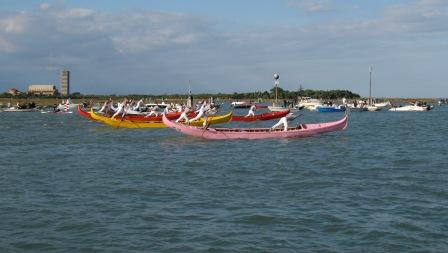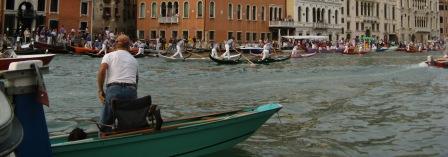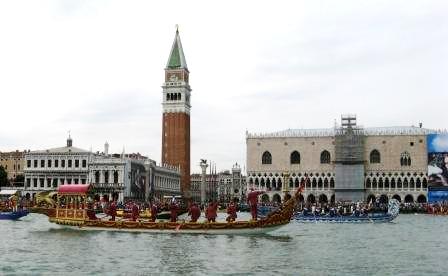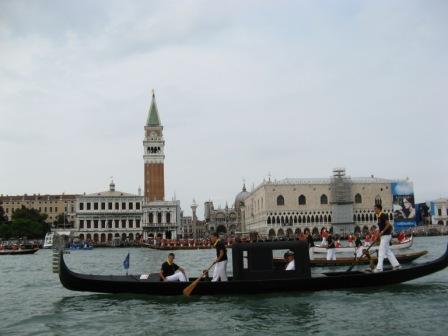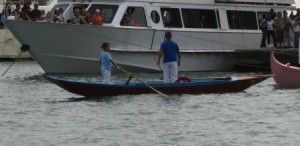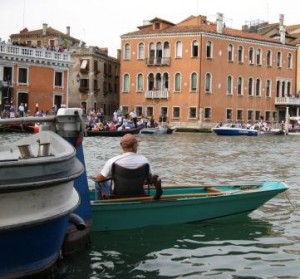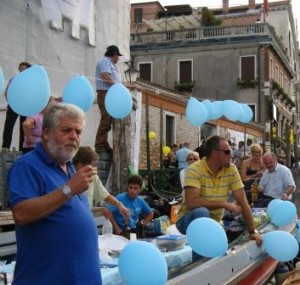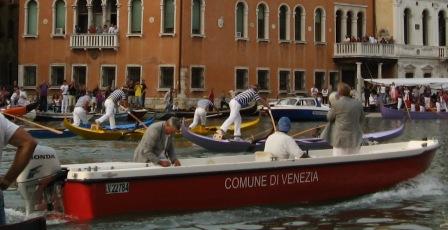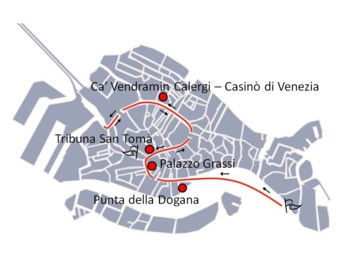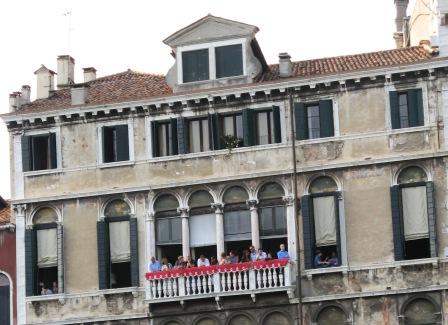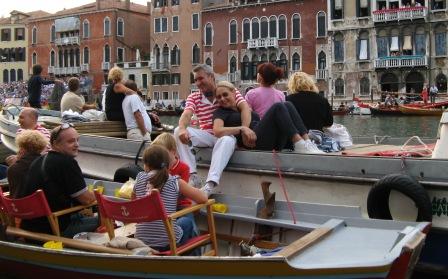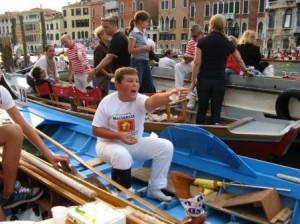The past few days in the world of the oar have been pretty agitated here.
The Commission of Discipline (no remarks please) has listened to the rowers and the judges involved in the dramatic events of the Regata Storica and has rendered its decision. An assortment of decisions, really, which amounted to throwing a couple of spare barrels of oil on the waves of accumulated anger.
Angry rowers are nothing new, and a fan that isn’t enraged and offended by something isn’t worthy of the name. But this time the judges — angry too, which also is no novelty — made the unusual step of revealing their antagonism to the public. This is an alarming sign of how far order in the world of Venetian racing has deteriorated.
And I sense that it’s not over yet, not least because when you throw oil on turbulent waters, you often get covered in oily spray. But usually the situation at that point is so perilous that the benefits outweigh the oil.
To review: Ivo Redolfi-Tezzat and Giampaolo D’Este (celeste gondolino) were disqualified in the throes of the Regata Storica on September 5, the most important and hugely most remunerative race of the year, because they did something(s) to prevent their lifelong rivals, Rudi and Igor Vignotto (canarin gondolino), from accomplishing some maneuver that might have been to their advantage. In fencing terms, this could be called the celeste parrying the thrust (or probable and/or imminent thrust) of canarin. Celeste was disqualified, canarin won.
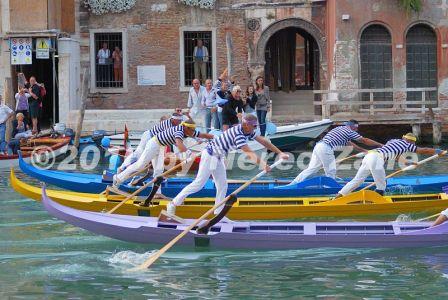
The Verdict: The appeal of Tezzat/D’Este was rejected. The new regulations stipulate that the judge’s verdict is unassailable, which in some ways ought to make the judges more punctilious. But that would be true only in an ideal world, and the Grand Canal is beautiful, but not ideal.
First point: Under the new rules, the order of finish is carved in titanium, hence celeste had no hope of being judged the winners in the cool light of the morning after. But that didn’t stop Tezzat/D’Este from registering a formal protest, hoping for a severe punishment to be inflicted on canarin. Hoping is fine, seeing as hope costs nothing. But their status as disqualifees remains unchanged.
Second point: The Vignottini did not escape completely unscathed, however. They received an official admonition (“diffida,” or warning) for “unsportsmanlike conduct” during the race. This is a black mark on their record, but does not comport any material damage.
Observation: I am not the only person who has noticed a certain incongruity between a decision which says that (A) celeste sinned and deserved its punishment but that (B) canarin also sinned but only needs a rap on the knuckles.

Third point: The judges. The two judges in the first boat, Gianni Tonini and Sandro Fort, were reprimanded for a series of errors which did not help, and perhaps aggravated, the situation during the race. In the simplest terms, their function (true for most judges) is to anticipate and prevent problems by timely warnings during the race. A judge, as one of them commented to me, doesn’t show how brilliant he is by the number of punishments he inflicts, but by the number of imminent problems he manages to resolve before punishment becomes inevitable. That didn’t happen here.
Tonini got an official “richiamo” from the Commission, and Fort got a richiamo because he let the race start even when the starting gun misfired. (As in: didn’t fire at all. The rules say the judge has to fire again and return all the racers to the starting line.) There were also a few commands issued to the rowers during the race by both men which are hard to justify even if you don’t care who won. But the important point is that this is the first time a judge has been publicly reprimanded.
Extra surprise: Startling but true, Ernesto Ortis, the coordinating judge, formally and publicly disassociated himself from the actions of Tonini and Fort. I believe this is a first here; like many groups, the judges have always prefered to present a united front even while they bicker inanely among themselves. It is no secret that bile has been bubbling for quite a while against the perceived hubris of Fort.
Outcome: The reaction to all these decisions (all of them wrong, of course, in the eyes of everybody except the commission) was to be seen at the regata at Burano last Sunday.
REVENGE AT BURANO
You may recall that the infuriated Tezzat first claimed they weren’t even going to try out for this, the last regata of the official season. But they did. Rowers make all kinds of affirmations that they never act on, usually some variation on “Take a good look at my oar, because it’s the last time you’re ever going to see it.” Next day, there they are.
So Tezzat and D’Este did the eliminations (What? Aren’t you supposed to be in Queen Maud Land?) and qualified for the race.
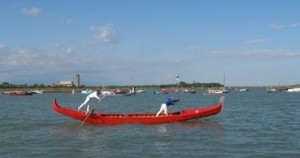
They showed up at Burano on Sunday on the green gondola. It was time for the race. All the gondolas were at the starting line, each poppiere (person rowing astern) clinging to the rope and struggling to keep his boat straight in the face of an annoying headwind and contrary tide.
But where’s green?
At the last minute, Tezzat and D’Este rowed, not to the starting line, but to the judge’s stand (all you racers just wait there till we’re done….). There they handed a piece of paper to the race announcer, who read it over the loudspeaker to the officials grouped on the dock, and to the suspenseful, murmuring hordes crushed along the water’s edge.
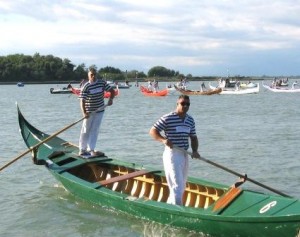
This document announced to the world, in the loftiest terms and the purest tones of innocent, persecuted victims, that Tezzat and D’Este would not only skip the race that was waiting to start, but won’t be racing again until All This gets cleared up once and for all. It was a sort of “J’accuse” aimed at the judges, collectively and individually (corrupt, incompetent, superannuated, cretinous) and at the Comune, represented by its execrable functionaries.
Their declaration did not use the exact terms employed by Emile Zola in his immortal denunciation (“…a great blow to all truth, all justice…”…”It is a crime to poison the small and the humble…”…all the revulsion of an honest man…”…”And these people sleep at night, and they have women and children whom they love!”). But I think they would have used those terms if they’d thought of it.
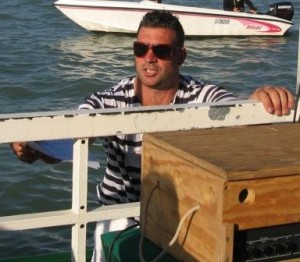
They then consigned a pair of symbolic oars to the new Counciler for Tourism, Roberto Panciera, and rowed back to the boathouse. I was on the dock and didn’t see anything oar-like changing hands, but maybe they were coffee spoons modified to look like oars.
This pantomime was not followed by stunned silence, it was followed by every shape and size of bellowed protest of passionate partisanship. There was one woman who yelled rolling phrases of excoriation in a voice of doom that could carry to the mainland and possibly farther. She was amazing. Just think, she could have summarized everything in the simple phrase “String ’em up,” but she clearly had quite a lot on her mind which had been pent up too long. If you’ve ever wondered what the vox populi might sound like, she was it.
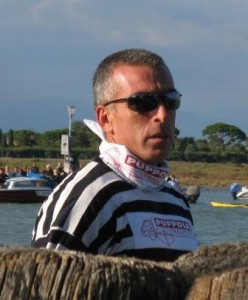
Then the race proceeded and the Vignottini won. No surprise there, naturally. God, how it rankled the public! I’ve never heard so many people so rankled. This was one situation where the daily habit of everybody talking at once turned out to be useful, because except for the Voice of Doom, you couldn’t understand anything anybody was saying. I thought about cheering for the Vignottini just to see what would happen, but the fans were like a mob of maenads, and I didn’t feel like being dismembered and devoured raw. Maybe some other time.
What next? I have no idea. There is already a sub-theme being promoted which demands the immediate dismissal of all the judges (why not — let’s just kill them all) and the installation of an entirely new cadre of judges, a new Commission of Discipline, a new everybody.
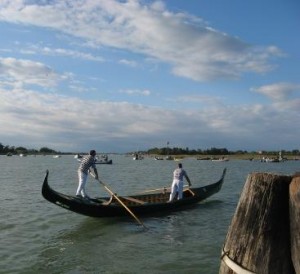
Only problem is, every time the Comune invites people to apply to become judges, nobody responds. Nobody wants to spend summer Sundays in all kinds of weather dealing with the racers, their relatives, and their fans who are howling that the judge’s dead relatives are dogs. Judges are likely to lose all their friends, too, who would suddenly regard them as unspeakable traitors. I know judges whose friends look the other way when they walk past on the street. I know: So they’re not real friends. But still. All this for 40 euros ($52) a race, and now there’s the chance to be publicly chastised as well? How could anybody turn that down?
The only option left to Tezzat for reclaiming his symbolic oar is to appeal to the mayor. The Vignottini resorted to this a few years ago, back before Igor threw his pennant into the canal in front of the mayor and their relationship turned to stone. But now there’s a different mayor, and let us not forget: Tezzat and D’Este are innocent.
I’ll see you on the barricades.
